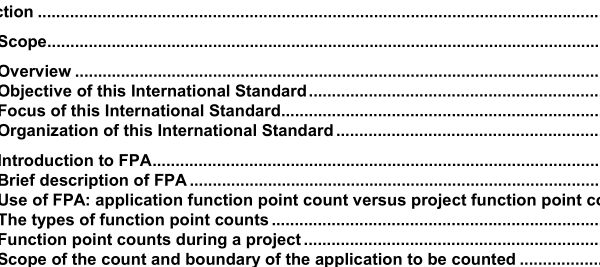ISO IEC 24570:2005 pdf download – Software engineering — NESMA functional size measurement method version 2.1 — Definitions and counting guidelines for the application of Function Point Analysis.
The committee is of the opinion that the changes made are chiefly an elaboration and further illustration of the guidelines drawn up earlier. In modifying the manual, the committee has worked in such a way that the changes made have as little effect as possible on the results of a function point analysis. Appendix D goes further into this. The guidelines published in this manual have been applied to a rather large case study with the title, FPA Case Study “Hotel” For The Application of Function Point Analysis. Applying the guidelines in practice is explained in this document in detail. The publication of this version takes precedence over versions 1.0 and 1.1, as well as the Addendum. English translation of version 2.0 (November 1997) This English version of the manual is an accurate translation of the Dutch version Version 2.1 Unadjusted (February 2002) This version has been developed for the manual to be an ISO recognized standard. The main adaptation is the exclusion of the General System Characteristics. This exclusion conforms to the ISO standard 14143-1 Functional Size Measurement. Reason for this International Standard The NESMA was set up in the spring of 1989. (At that time it was called the NEFPUG.) During its first meeting in June, it carried out a study among its participants in order to survey which subjects they were interested in. The standardization of counting guidelines/definitions was high on the list. In reaction to this, the NESMA Board decided to set up a committee devoted to this topic. This committee set itself the task of putting together a International Standard for the theoretical application and the practical use of function point analysis (FPA) 1 . Over the years a number of “dialects” have arisen for FPA. These dialects complicate the goal of determining the number of function points and make it almost impossible for organizations to compare results. One insufficiently acknowledged reason for this is that different interpretations of the “Albrecht” method have arisen. This International Standard hopes to provide clarity by formulating standards for the definitions and counting guidelines that pertain to FPA. Intended audience This International Standard is meant for everyone who performs function point counts; i.e., both for people who count according to the NESMA rules and for those who use the IFPUG rules. For those using the IFPUG rules, the NESMA International Standard can be a valuable supplement to the IFPUG International Standard if the differences stated on the website “WWW.NESMA.ORG” are taken into account. The NESMA International Standard, after all, contains many hints, guidelines, and examples that can be of value to every FPA counter. It is assumed that the reader has some knowledge of FPA. Nevertheless, we have also attempted to produce as complete a International Standard as possible that includes sufficient introductory material and explanation for the new FPA user. For both the maintenance of the IFPUG International Standard and the NESMA International Standard there is a co-operation between the IFPUG CPC and the NESMA CPC.
ISO IEC 24570:2005 pdf download – Software engineering — NESMA functional size measurement method version 2.1 — Definitions and counting guidelines for the application of Function Point Analysis






